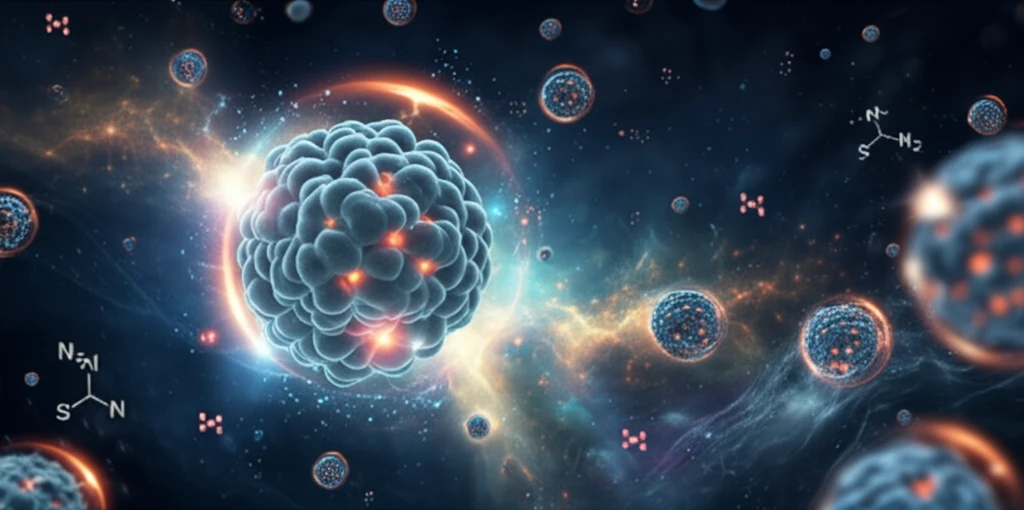
Superoxide Surge: Unlocking Ceria's Nanoscale Secrets for a Greener Future
"How hybrid DFT calculations are rewriting the rules of oxygen storage in ceria nanoparticles, paving the way for enhanced catalytic converters and sustainable energy solutions."
Ceria (CeO2), a reducible oxide material, stands as a cornerstone in oxidation catalysis, celebrated for its ability to facilitate reactions either as a promotor or an active catalyst. This remarkable versatility stems from the dual nature of cerium cations, which readily switch between Ce4+ and Ce3+ oxidation states depending on their immediate environment. This property makes ceria invaluable in energy-related applications, notably as an oxygen storage component in automotive catalytic converters and as an electrolyte in solid-state fuel cells.
In automotive exhaust treatment and other high-temperature processes, ceria's primary role is that of an oxygen storage material. Its capacity to maintain a high oxidative state under fluctuating conditions is well-documented, with its effectiveness closely tied to its ability to form and heal oxygen vacancies. However, a different behavior emerges at the nanoscale. Studies on ceria nanoparticles, particularly those around 5 nm, reveal a dramatic increase in oxygen storage capacity (OSC). This enhanced OSC has been linked to the formation of superoxide ions (O2-) on the nanoparticle surfaces.
Recent experiments and advanced density functional theory (DFT) calculations are helping to unravel the mystery behind ceria's nanoscale oxygen storage. While previous DFT studies using the PBE+U functional provided qualitative insights, they fell short in accurately predicting the stability of superoxide ions at room temperature. This discrepancy prompted researchers to explore hybrid DFT methods, which offer a more refined approach to understanding the energy dynamics associated with localized f-electrons and oxygen p-levels. The latest findings promise to bridge the gap between theory and experiment, offering a pathway to optimize ceria nanoparticles for a wide array of applications.
The Superoxide Connection: Why Nanoscale Ceria Excels at Oxygen Storage

The enhanced oxygen storage capacity (OSC) of ceria nanoparticles has sparked significant interest in the scientific community. Unlike bulk ceria, where oxygen vacancies play a crucial role, nanoscale ceria exhibits a different mechanism involving the formation of superoxide ions (O2-) on its surface. These ions are created when oxygen molecules adsorb onto the ceria surface and gain an electron, a process facilitated by the presence of Ce3+ ions. This "supercharging" effect allows the nanoparticles to store and release oxygen more efficiently, boosting their catalytic performance.
- Hybrid DFT to the Rescue: Hybrid DFT methods, such as HSE06, incorporate a portion of exact exchange from Hartree-Fock theory, providing a more accurate representation of electron localization and charge transfer.
- Correcting the Energy Estimate: The discrepancy between theory and experiment stems from an incorrect estimate of the energy associated with localized f-electrons in cerium and the oxygen p-levels. Hybrid DFT rectifies this, leading to more realistic adsorption energies.
- Superoxide Stability Confirmed: Using hybrid DFT, researchers have confirmed that superoxide ions are indeed stable on nanosized ceria well above room temperature, aligning with experimental findings.
Looking Ahead: The Future of Ceria Nanoparticles in Sustainable Technologies
The insights gained from hybrid DFT calculations are not just theoretical advancements; they have practical ramifications for a range of sustainable technologies. As we move towards cleaner energy solutions and more efficient industrial processes, ceria nanoparticles are poised to play a pivotal role. Further research into the kinetics of oxygen adsorption and desorption, as well as the effects of different nanoparticle shapes and sizes, will undoubtedly unlock even greater potential. By harnessing the power of nanoscale ceria, we can pave the way for a greener and more sustainable future.
